Real Sociedad and Monaco played out a very edgy affair this past Thursday at the Reale Arena in a game that ended 1-1 in the UEFA Europa League group stages.
This was arguably the most-anticipated fixture from the second gameweek featuring two of the competition’s biggest teams.
Following a 2-2 draw with PSV Eindhoven in the opening game of the Europa League group phase, Imanol Alguacil was hoping that his side could pick up all three points, but La Real found themselves 1-0 down early in the first half through an Axel Disasi header from a corner.
However, within the opening ten minutes of the first half, the former Newcastle United midfielder Mikel Merino equalised yet another corner goal. Niko Kovac’s Monaco frustrated the home side and manager to hold on for a point despite having just 37.04 percent of the ball and just 6 shots throughout the entire game.
The game was certainly not a classic but the quality on display from the players was sumptuous at times. It was also a very tactical battle between two high-profile coaches in their own regard.
This article will be a tactical analysis of the game between the two teams. It will be an analysis of the most effective tactics used by both managers throughout the match.
Lineups and formations
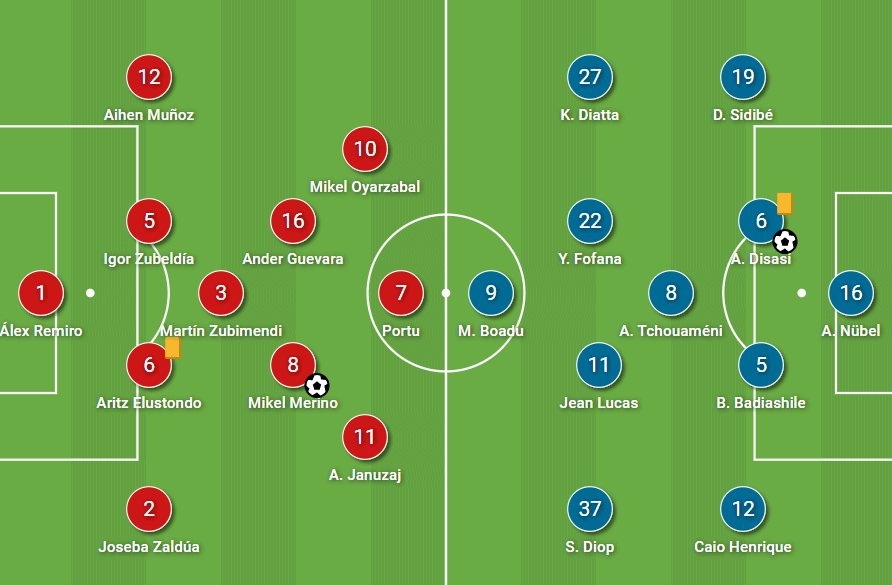
As the fans have become accustomed to under Alguacil, La Real set up in a 4-3-3 as their base formation, although this is fluid in possession, and while out of possession it can switch to a 4-4-2 with ease.
Álex Remiro started in goal for Thursday’s match against Monaco and was protected by a back four consisting of Aihen Muñoz at left-back, Joseba Zaldúa at right fullback with Igor Zubeldia partnering alongside Aritz Elustondo at centre-back.
Martín Zubimendi was deployed as the single pivot in Real Sociedad’s three-man midfield and was supported by Merino and Ander Guevara. The front three comprised of the former Manchester United winger Adnan Januzaj, and Mikel Oyarzabal on the wings flanking the versatile Portu.
Regarding Monaco, Kovac switched to more of a 4-5-1 despite utilising a 4-2-3-1 last Sunday in a 3-1 win over Clermont Foot in Ligue 1. Quite a few players were changed too from that same victory.
Alex Nübel began in net, protecting the goal behind a backline made up of Caio Henrique, Benoît Badiashile, Disasi, and Djibril Sidibé.
Aurélien Tchouaméni, Youssouf Fofana, and Jean Lucas were used in the middle of the park as the three-man midfield and were flanked by Sofiane Diop and Krépin Diatta on the wings whilst the ex-AZ Alkmaar star Myron Boadu began up top.
Monaco struggling with La Real’s high press
As already stated, Monaco had inferior possession to Real Sociedad in this European tie. The French club did try and play out with their backline and goalkeeper in the early stages of the game but were struggling to do so due to the opposition’s excellent man-oriented high pressing scheme.
When Monaco had the ball in a positional attack in deeper areas of the pitch, Kovac set his team up in a 3-2 structure with the backline and two central midfielders. Sidibe would always stay back with the two centre-backs and allow Henrique to bomb on while Lucas would drop alongside Tchouaméni and form a double-pivot.
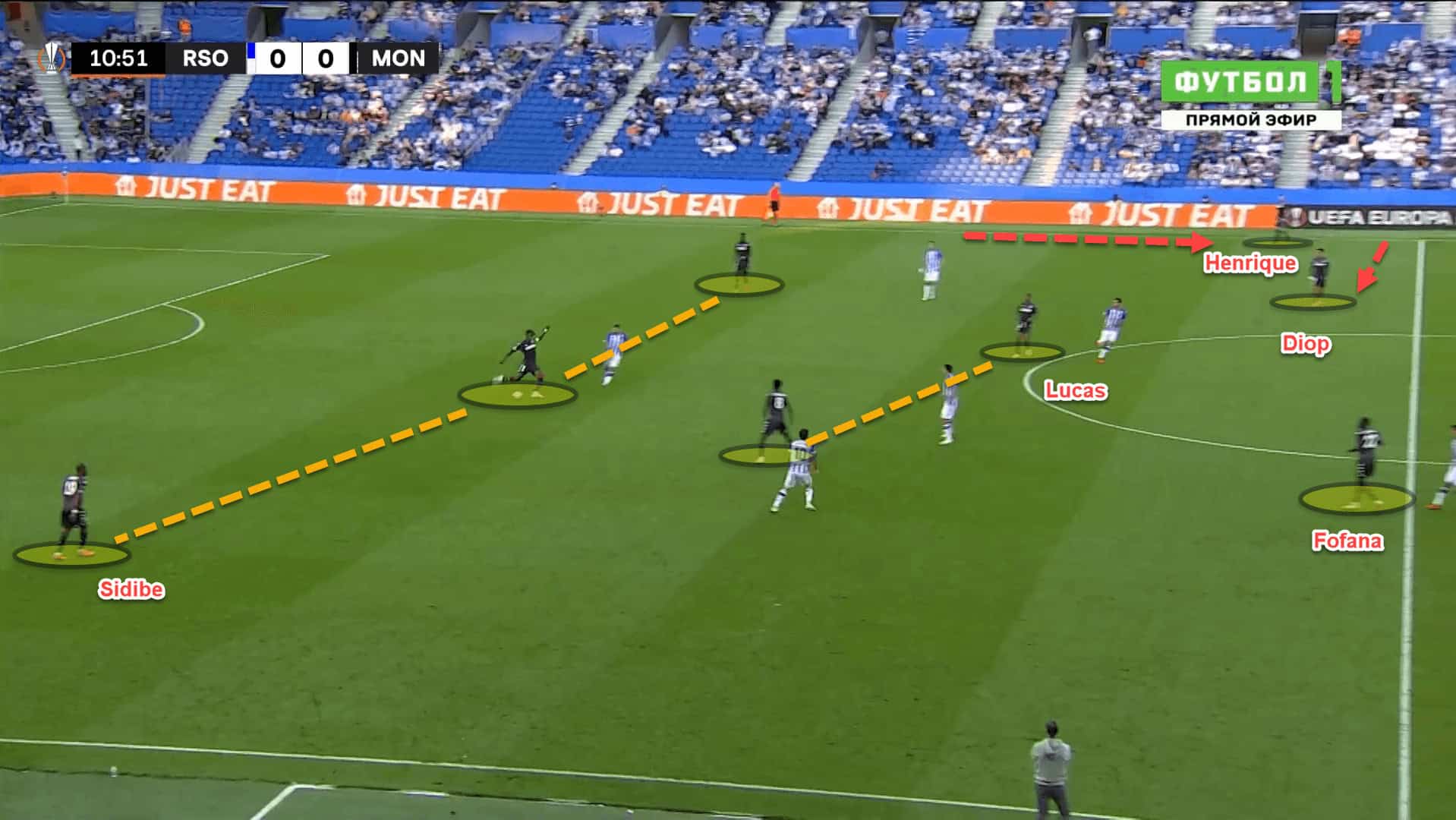
This set-up can be seen in the above image. Henrique pushing on has allowed Diop to come inside and occupy space between the lines to receive the ball. Fofana also moved into this area and operated in very high areas throughout the game.
On the far right, the width was held by Diatta who maintained a wide position on the flanks to stretch La Real. This is because Sidibe was shackled to stay back and form a three-man line with the two central defenders, so somebody had to keep the width on this side in order to stretch Alguacil’s men.
The issue for Kovac’s team was that the three-man backline could not get the ball into the players between the lines very often due to Real Sociedad’s excellent press.
La Real used a 4-1-4-1 structure out of possession and went man-for-man with the defenders and double-pivot. Their approach was aggressive had clear intent to regain possession, not just force them into a certain area.
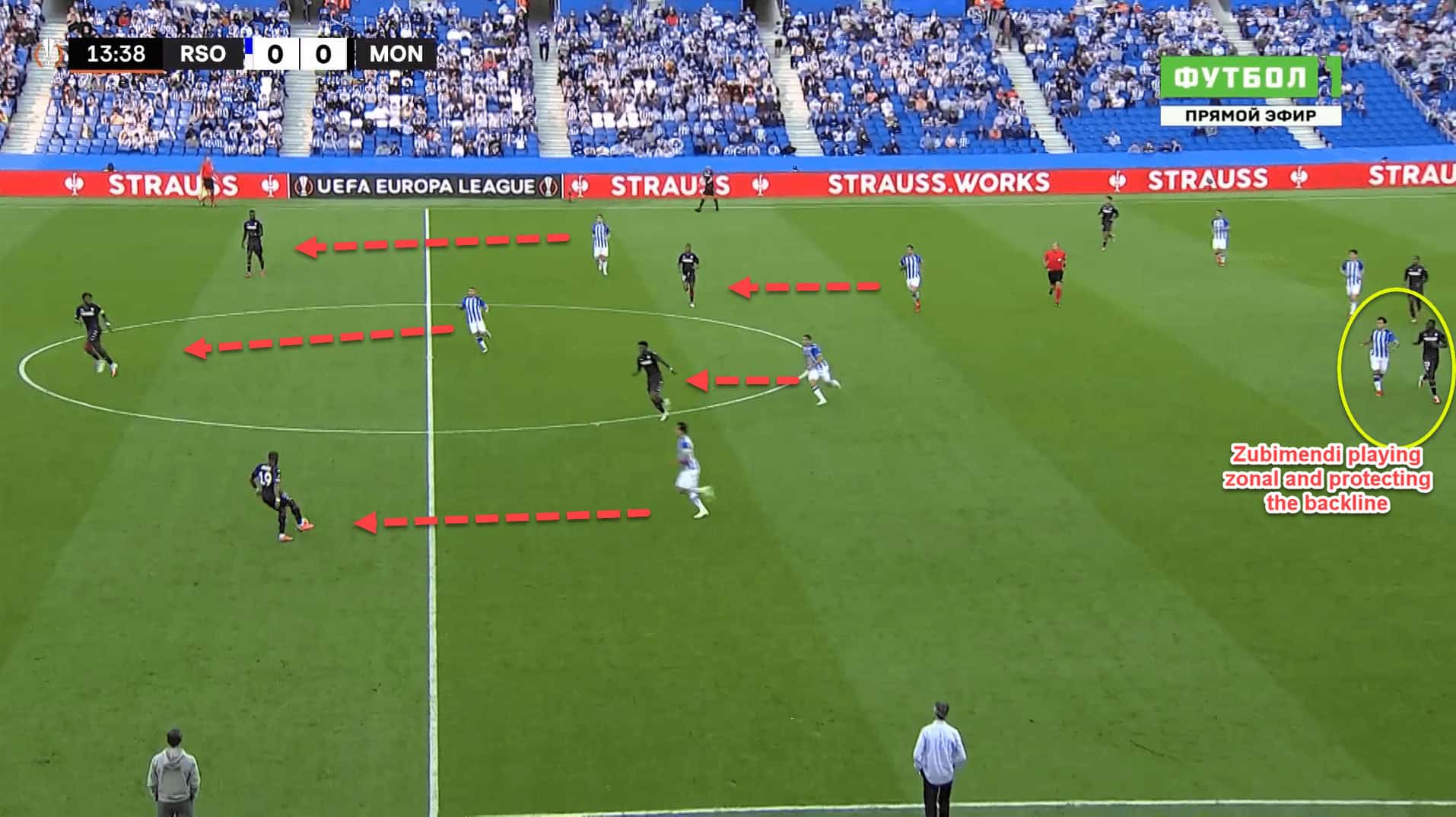
Here is Real Sociedad’s man-oriented press in action while Monaco are in a structured positional attack. The wingers would press the wide centre-backs while Portu would press the central defender.
The players would press out-to-in which would force the Monaco three-man backline to play inside to the two central midfielders where Guevara and Merino would jump them from behind.
Meanwhile, Zubimendi was tasked with playing zonally and cutting out any dangerous passing lanes between the lines, protecting the backline.
Early in the first half, situations like this occurred more than once from Real Sociedad’s press and put Monaco under real pressure as they were losing possession in very dangerous areas of the pitch in their own half.
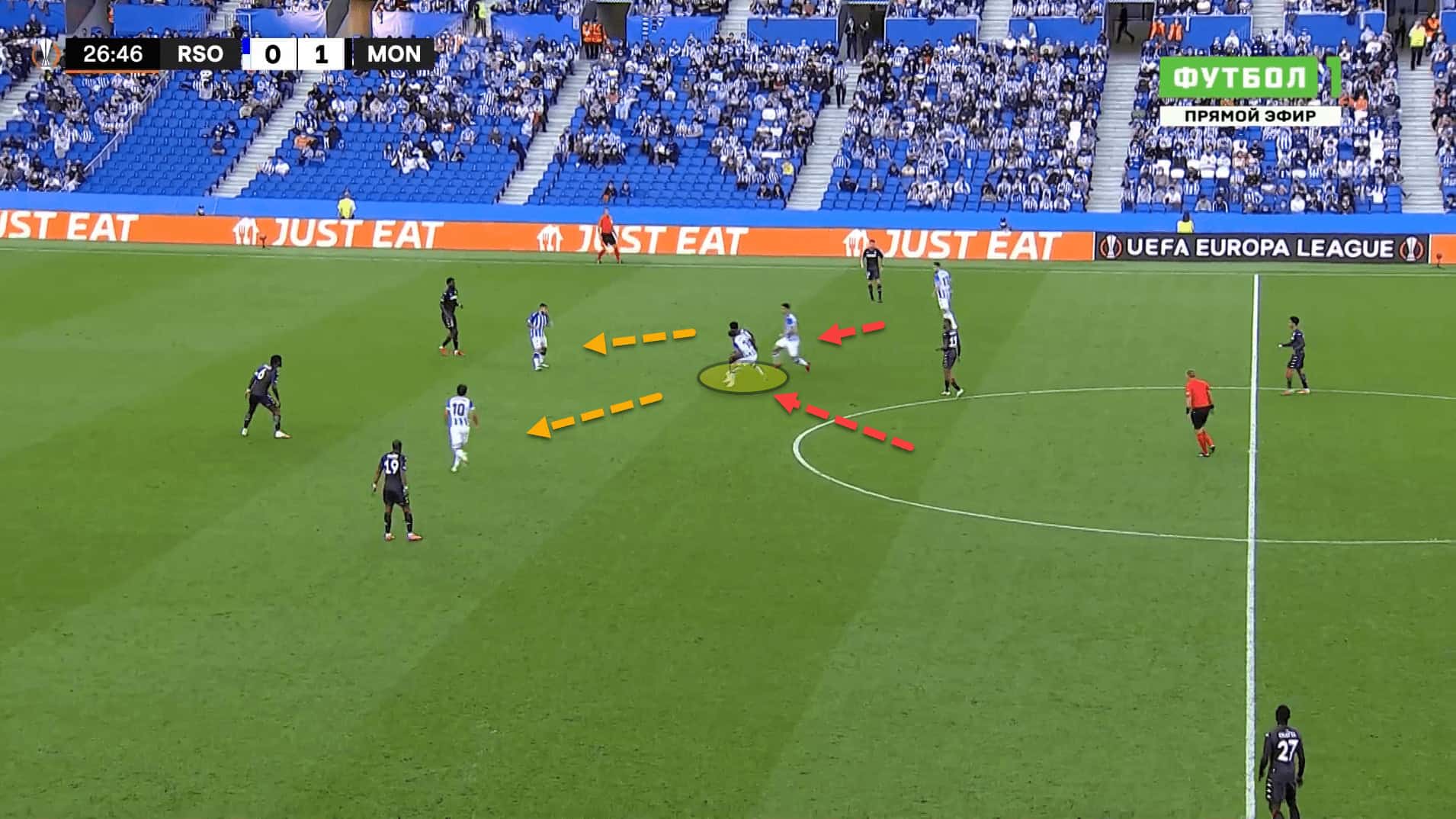
Here, Tchouaméni has received the ball from the defenders with his back to goal and has been jumped instantly by the two central midfielders who regain possession successfully and hit Monaco on the break in a 4v3 situation. Nothing came of the attack in the end but Kovac was certainly worried about it becoming a recurring theme.
The Monégasques began to play more long balls towards Boadu up front who was causing the two centre-backs trouble as his hold-up play was very solid throughout the match. A lot of Monaco’s attacks came from winning the second ball from a direct pass to the Dutchman.
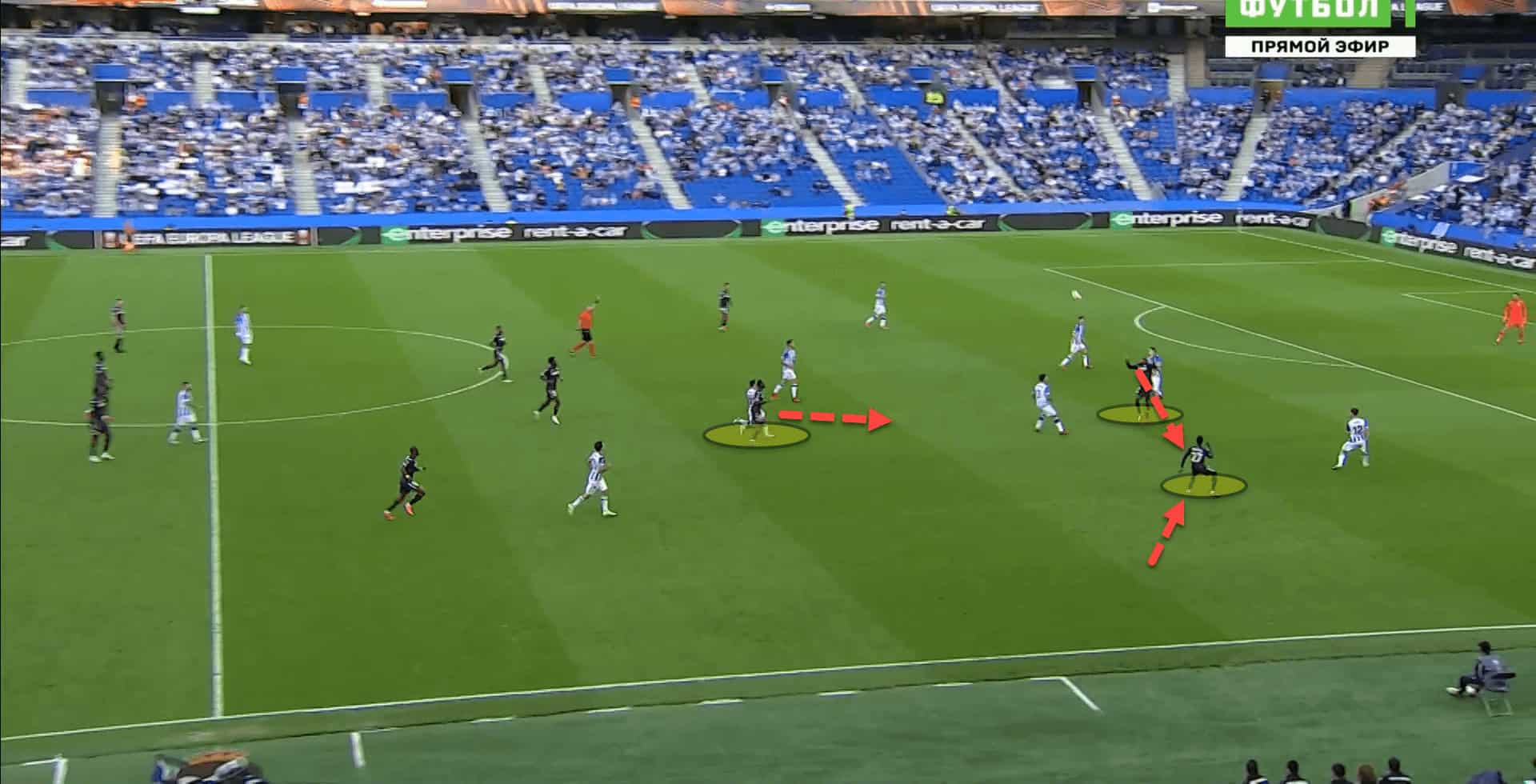
Fofana constantly made runs in behind Real Sociedad’s backline too despite playing in midfield. The 22-year-old was essentially playing as a second striker in this European tie when Monaco had possession of the ball
This can be seen from the team’s average positions and most used passes map.
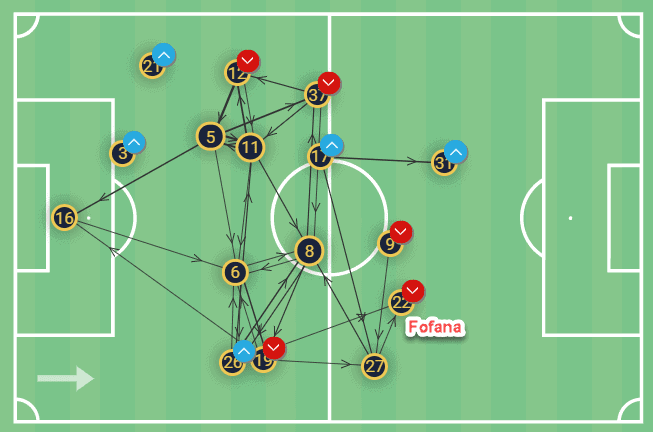
What is extremely interesting about this from an analytical perspective is that Fofana played further forward on average than Boadu which proves the differing roles each player had.
Boadu would drop a lot to receive to feet or to contest a long ball while Fofana was constantly attacking the depth and stretching Real Sociedad’s backline vertically.
The young French midfielder was really important for Monaco as they struggled to bypass the home side centrally and so could go long into the channels towards him in order to try and break them down.
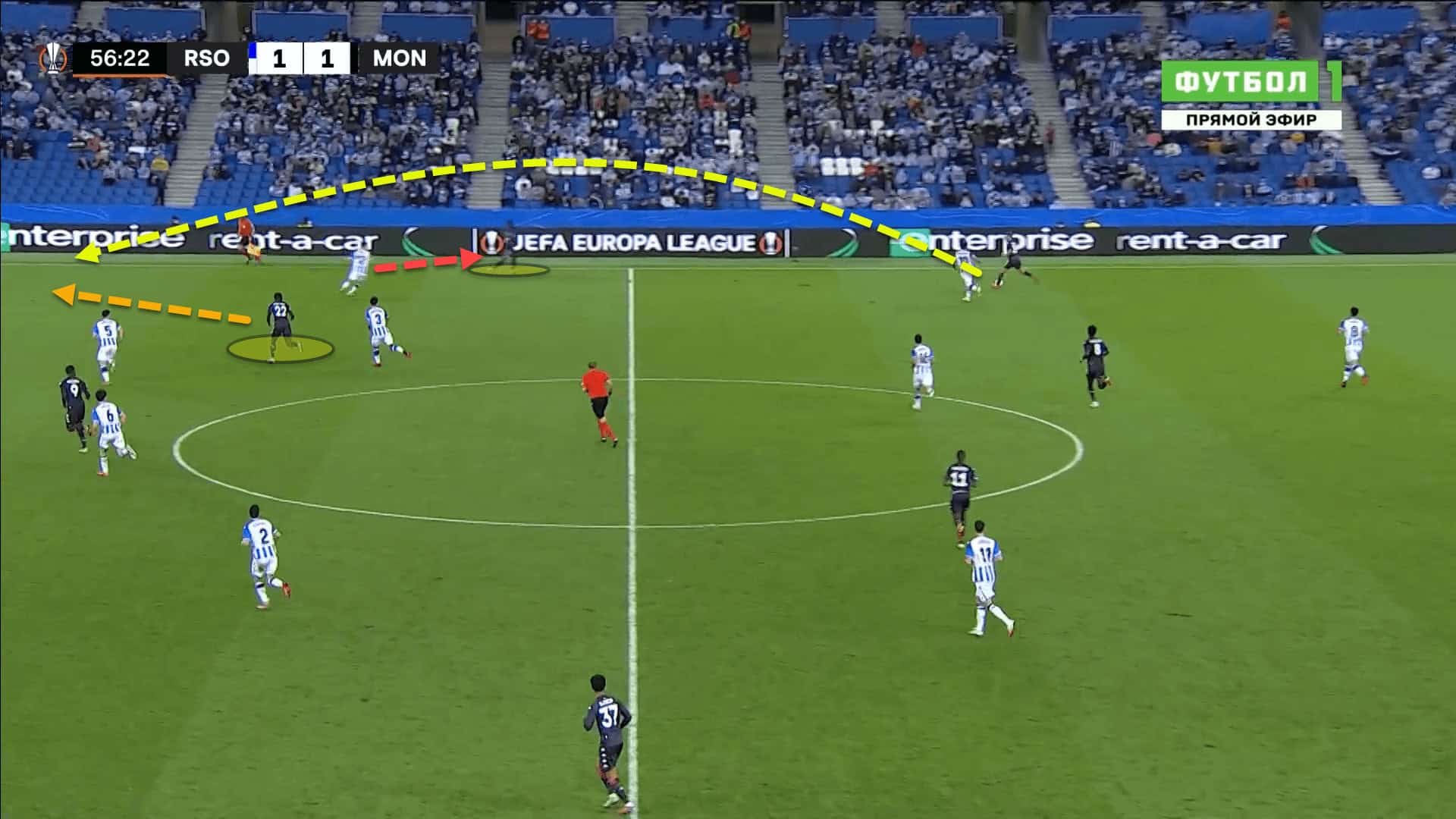
Here, La Real’s left-back has been attracted towards Diatta and has left space on the flank to be exploited. Fofana spots his chance to make a run down this channel and latches onto a great ball from Ruben Aguilar, who replaced Sidibe early in the second half.
Monaco frustrate Real Sociedad
Defensively, Monaco were exceptional. The only goal the French team conceded was from an excellent header by Merino at a corner. Besides this, Monaco were very well-drilled in their defensive approach which is a credit to the ex-Bayern Munich boss and his coaching staff.
Monaco did not press high at all and were more than happy to allow La Real to have possession of the ball in the first third of the pitch. Their Passes allowed Per Defensive Action (PPDA) in the game was 21.55. In contrast, the home side’s PPDA was 5.93.
To put this into context, Monaco were allowed almost 16 extra passes to happen before making a defensive action compared to their opponents in this match.
Nonetheless, their lack of pressing worked, and they were focused instead on dropping into a 4-5-1 mid-to-low defensive block and denying Real Sociedad any access to the central areas.
From Monaco’s defensive duels map, it can be interpreted easily that the tactical instructions that Kovac gave to his players were to force Real Sociedad wide and win the ball back on the flanks.
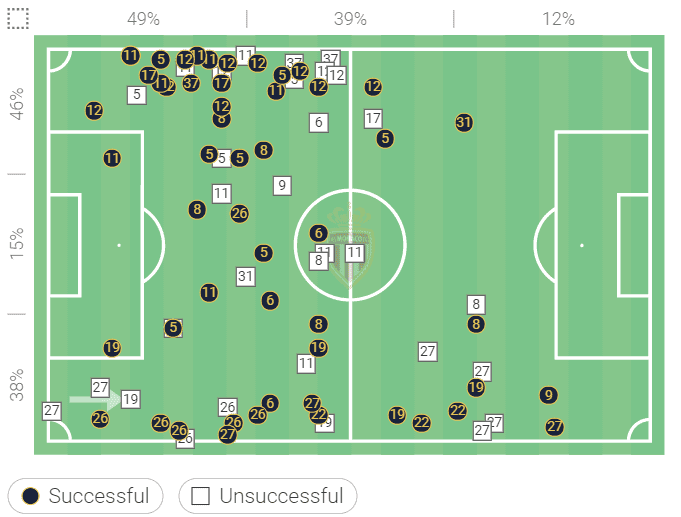
There were very few defensive duels on Monaco’s part in the middle of the park. The vast majority came from the wings, particularly down the French team’s left. Henrique had an excellent game at left-back with the help of Diop tracking back and Lucas pushing across to cover.
When Monaco would force Real Sociedad wide, they would push their entire defensive block across in unison. From here, the nearest players would try and cut off all passing lanes for La Real, forcing them to play backwards or cause a turnover of possession.

Monaco were not passive in their approach though and the players were constantly closing down players and blocking lanes for the opposition.
In the above image, the French team is sitting in a 4-5-1/4-1-4-1 mid-block. Here, Real Sociedad have been forced wide with their possession and the right-back has no players open as Monaco have covered all of the nearest passing lanes ahead and inside of him. To avoid losing possession to Diop – who is applying pressure in the scenario to the ball-carrier – the defender plays backwards to the closest centre-back.
The only issue was that it left a player free on the far side to receive a switch of play in a plethora of space, but Alguacil’s team struggled to take advantage of this a lot of the time.
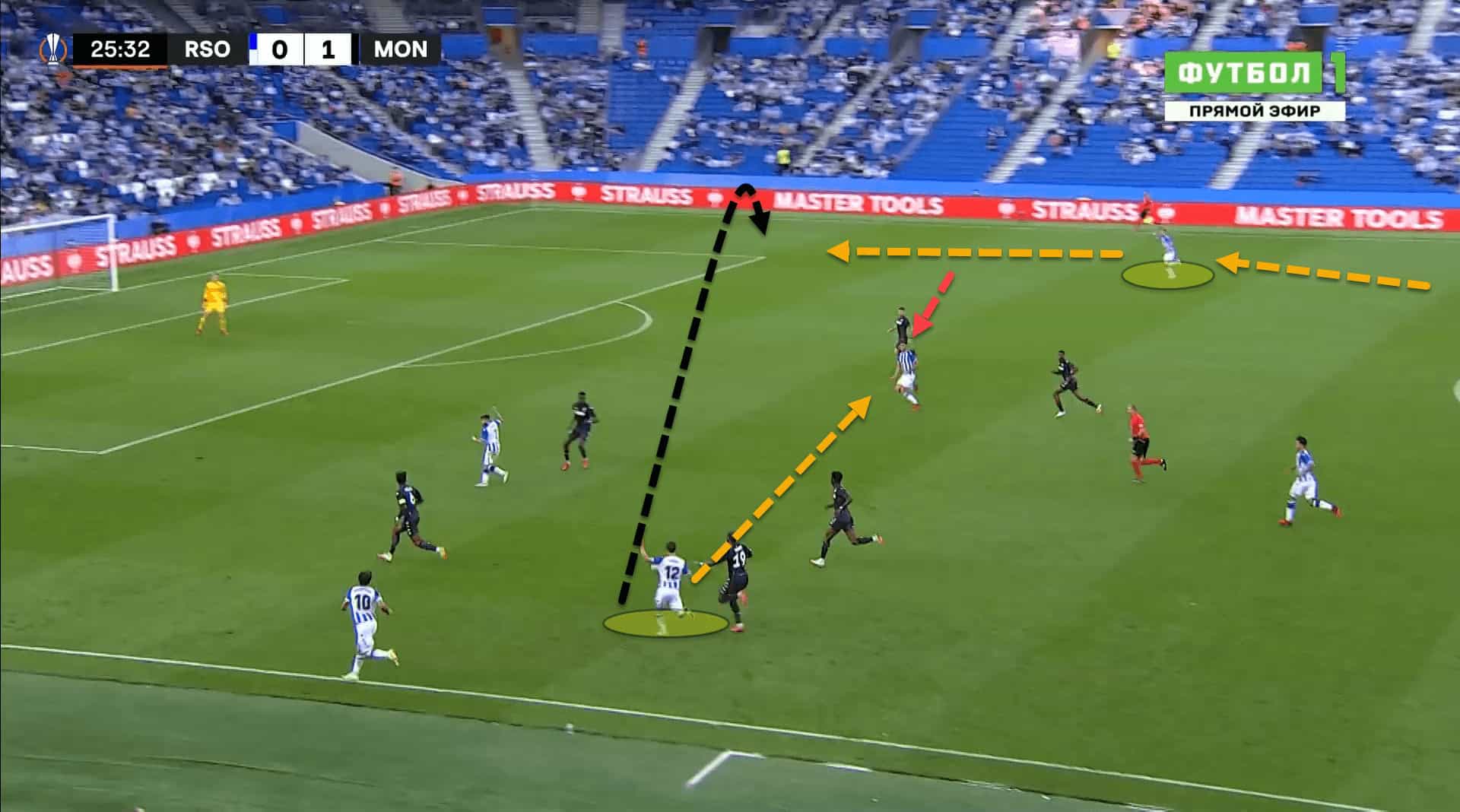
This example was arguably the best opportunity Real Sociedad had to execute it, but the fullback opted to play inside rather than out wide – predominantly because of his poor body orientation in this situation.
When the ball was more central, Fofana would push himself up alongside Boadu to form a two-man first line of pressure while applying a cover shadow to block any passing lanes behind him.
It would have been too easy for La Real to progress past Monaco’s first line of pressure if Fofana hadn’t have been applying pressure alongside him. The Frenchman was also key in forcing the home defenders wide by angling his run whilst pressing.
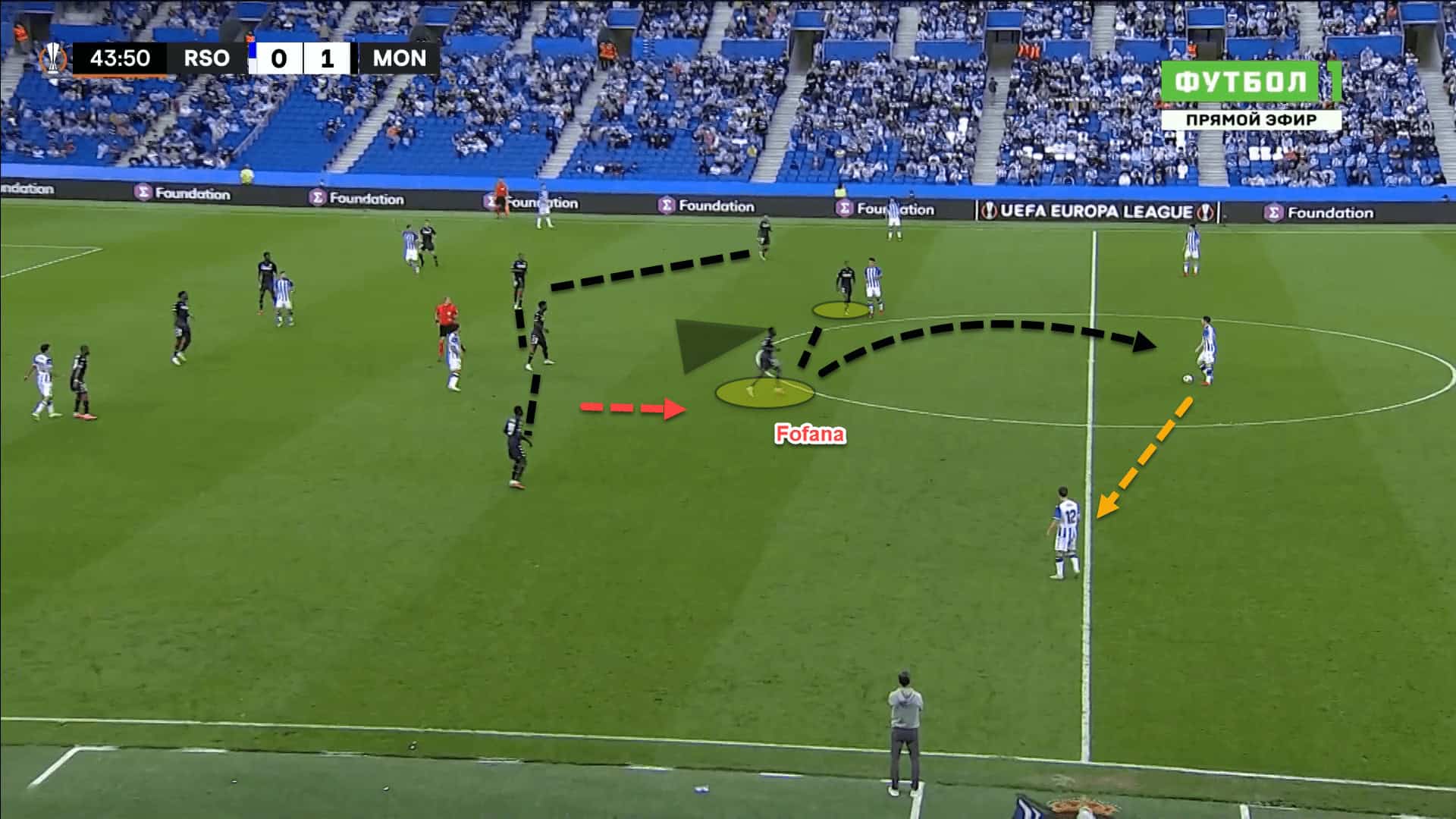
Their defensive set-up was almost flawless and Real Sociedad accumulated an expected goals total (xG) of 1.29 despite having 62.96 percent of the ball over the course of the game and 31 positional attacks.
Switch to a 5-4-1
After the second half began, Monaco found it really difficult to create many chances or even get shots on goal. They were still sitting in their deep defensive block well into the latter stages of the game and Real Sociedad had bagged an equaliser and were looking for a winner.
Kovac made a controversial decision to take off a forward player in Diop and bring Guillermo Maripán onto the field, switching to a back five and playing a 5-4-1 out of possession.
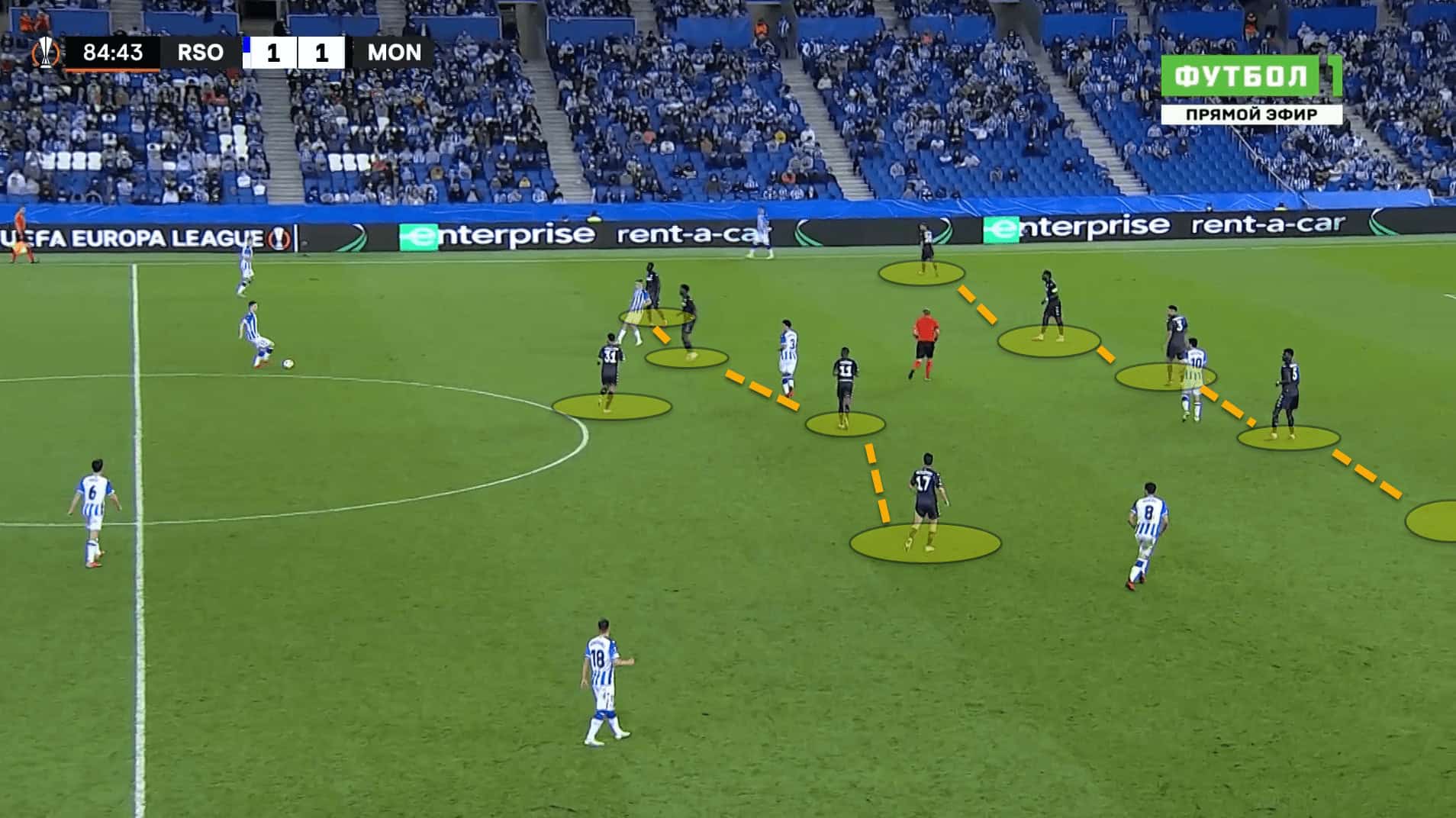
The approach remained the same; contain, cut off central passing lanes, and force Real Sociedad wide.
Switching to a back five also helped them defend against the switches of play, which were spoken about in the previous section, as Monaco now had a man over on the far side who could get across quickly to press.
Monaco looked less secure between the lines because of the loss of a central defensive midfield player, but the addition of an extra defender allowed the centre-backs to be aggressive and come out of their line to close down opposition players in this area.
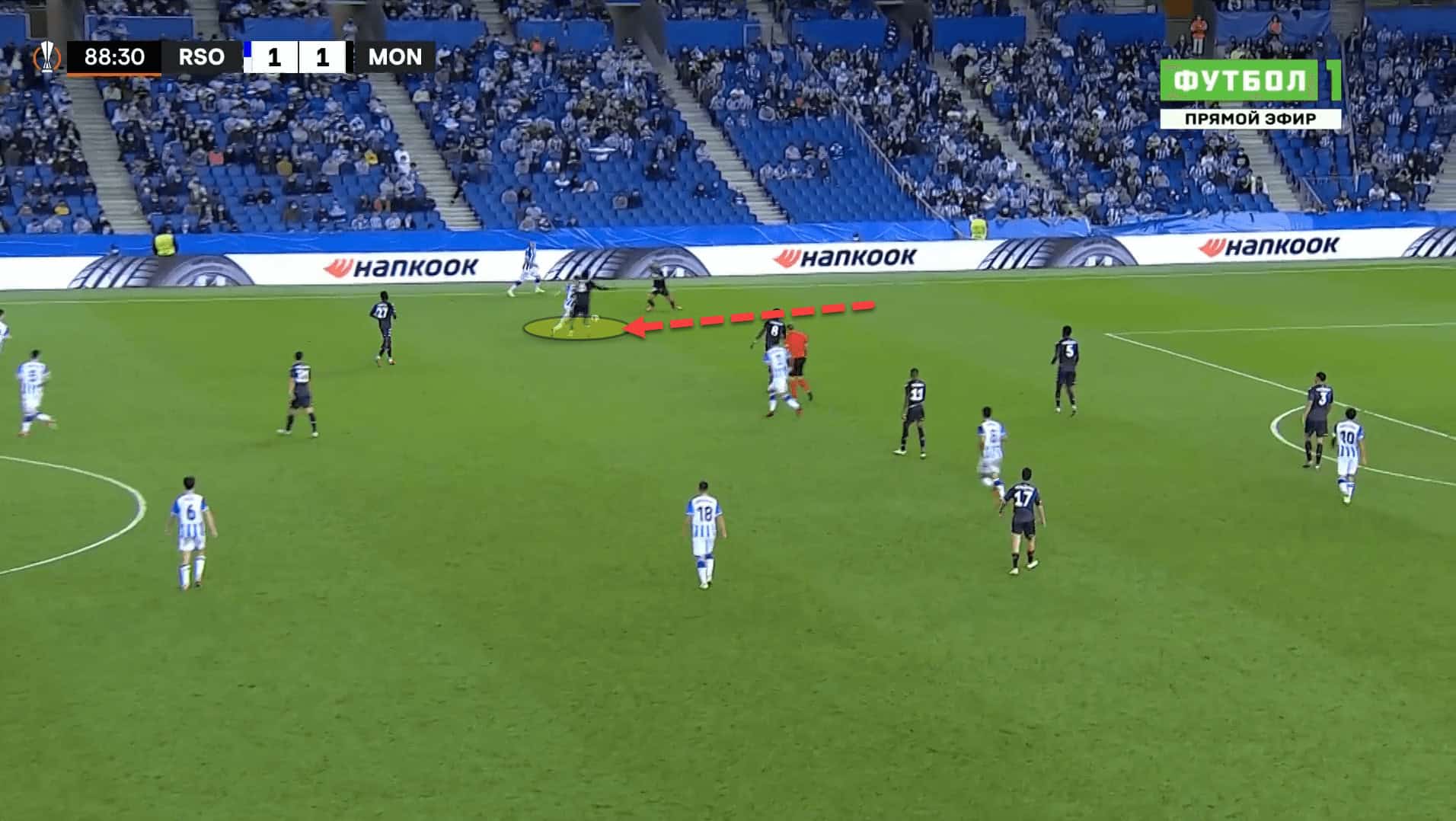
Here, Real Sociedad have broken through Monaco’s midfield and have the ball in between the lines but Disasi – who was playing as the right centre-back – pushed out aggressively to close the ball-carrier down and prevent the attack from going any further.
Conclusion
Niko Kovac claimed after the game that he was very happy with the result as it was a draw away from home against a team who are sitting in second place in La Liga.
The former Bayern and Eintracht Frankfurt boss masterminded a wonderful defensive performance which was executed brilliantly by the players. While Monaco looked rather toothless up front, for the most part, accumulating an xG of just 0.49, they were defensively disciplined and there are far more positives for the French giants than negatives.
Alguacil’s men can be more frustrated than disappointed as the performance certainly was not poor. However, La Real desperately struggled to break down Monaco’s defensive structure and had to settle for a disheartening draw in the end.






Comments